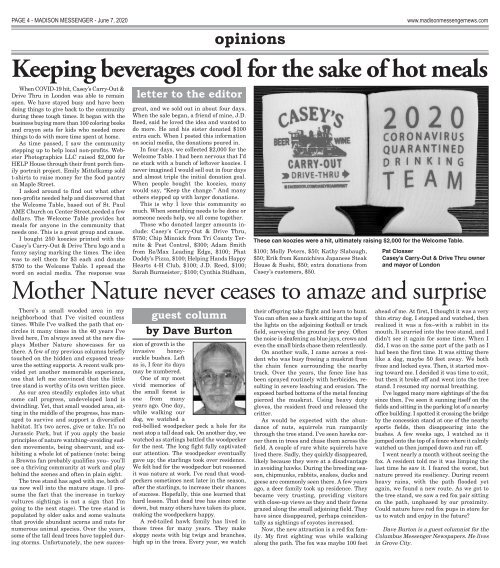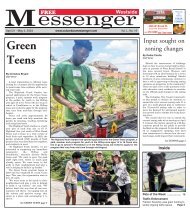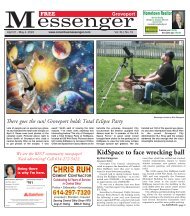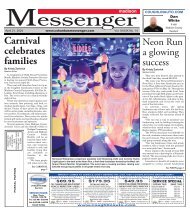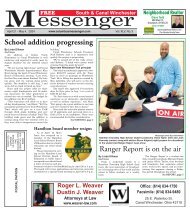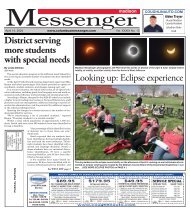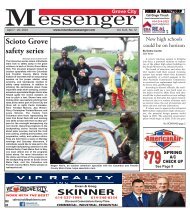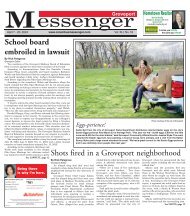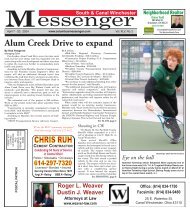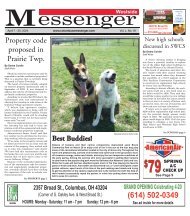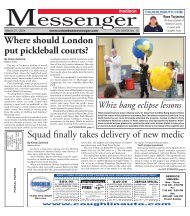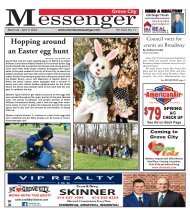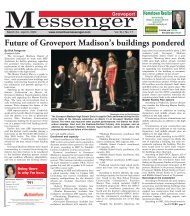Madison Messenger - June 7th, 2020
You also want an ePaper? Increase the reach of your titles
YUMPU automatically turns print PDFs into web optimized ePapers that Google loves.
PAGE 4 - MADISON MESSENGER - <strong>June</strong> 7, <strong>2020</strong><br />
opinions<br />
www.madisonmessengernews.com<br />
Keeping beverages cool for the sake of hot meals<br />
When COVID-19 hit, Casey’s Carry-Out &<br />
Drive Thru in London was able to remain<br />
open. We have stayed busy and have been<br />
doing things to give back to the community<br />
during these tough times. It began with the<br />
business buying more than 100 coloring books<br />
and crayon sets for kids who needed more<br />
things to do with more time spent at home.<br />
As time passed, I saw the community<br />
stepping up to help local non-profits. Webster<br />
Photographics LLC raised $2,000 for<br />
HELP House through their front porch family<br />
portrait project. Emily Mittelkamp sold<br />
t-shirts to raise money for the food pantry<br />
on Maple Street.<br />
I asked around to find out what other<br />
non-profits needed help and discovered that<br />
the Welcome Table, based out of St. Paul<br />
AME Church on Center Street,needed a few<br />
dollars. The Welcome Table provides hot<br />
meals for anyone in the community that<br />
needs one. This is a great group and cause.<br />
I bought 250 koozies printed with the<br />
Casey’s Carry-Out & Drive Thru logo and a<br />
funny saying marking the times. The idea<br />
was to sell them for $3 each and donate<br />
$750 to the Welcome Table. I spread the<br />
word on social media. The response was<br />
letter to the editor<br />
great, and we sold out in about four days.<br />
When the sale began, a friend of mine, J.D.<br />
Reed, said he loved the idea and wanted to<br />
do more. He and his sister donated $100<br />
extra each. When I posted this information<br />
on social media, the donations poured in.<br />
In four days, we collected $2,000 for the<br />
Welcome Table. I had been nervous that I’d<br />
ne stuck with a bunch of leftover koozies. I<br />
never imagined I would sell out in four days<br />
and almost triple the initial donation goal.<br />
When people bought the koozies, many<br />
would say, “Keep the change.” And many<br />
others stepped up with larger donations.<br />
This is why I love this community so<br />
much. When something needs to be done or<br />
someone needs help, we all come together.<br />
Those who donated larger amounts include:<br />
Casey’s Carry-Out & Drive Thru,<br />
$750; Chip Minnick from Tri County Termite<br />
& Pest Control, $300; Adam Smith<br />
from Re/Max Leading Edge, $100; Phat<br />
Daddy’s Pizza, $100; Helping Hands Happy<br />
Hearts 4-H Club, $100; J.D. Reed, $100;<br />
Sarah Burmeister,: $100; Cynthia Stidham,<br />
These can koozies were a hit, ultimately raising $2,000 for the Welcome Table.<br />
$100; Molly Peters, $50; Kathy Slabaugh,<br />
$50; Erik from Konnichiwa Japanese Steak<br />
House & Sushi, $50; extra donations from<br />
Casey’s customers, $50.<br />
Pat Closser<br />
Casey’s Carry-Out & Drive Thru owner<br />
and mayor of London<br />
Mother Nature never ceases to amaze and surprise<br />
There’s a small wooded area in my<br />
neighborhood that I’ve visited countless<br />
times. While I’ve walked the path that encircles<br />
it many times in the 40 years I’ve<br />
lived here, I’m always awed at the new displays<br />
Mother Nature showcases for us<br />
there. A few of my previous columns briefly<br />
touched on the hidden and exposed treasures<br />
the setting supports. A recent walk provided<br />
yet another memorable experience,<br />
one that left me convinced that the little<br />
tree stand is worthy of its own written piece.<br />
As our area steadily explodes into what<br />
some call progress, undeveloped land is<br />
dwindling. Yet, that small wooded area, sitting<br />
in the middle of the progress, has managed<br />
to survive and support a diversified<br />
habitat. It’s two acres, give or take. It’s no<br />
Jurassic Park, but if you apply the basic<br />
principles of nature watching—avoiding sudden<br />
movements, being observant, and exhibiting<br />
a whole lot of patience (note: being<br />
a Browns fan probably qualifies you— you’ll<br />
see a thriving community at work and play<br />
behind the scenes and often in plain sight.<br />
The tree stand has aged with me, both of<br />
us now well into the mature stage. (I presume<br />
the fact that the increase in turkey<br />
vultures sightings is not a sign that I’m<br />
going to the next stage). The tree stand is<br />
populated by older oaks and some walnuts<br />
that provide abundant acorns and nuts for<br />
numerous animal species. Over the years,<br />
some of the tall dead trees have toppled during<br />
storms. Unfortunately, the new succes-<br />
guest column<br />
by Dave Burton<br />
sion of growth is the<br />
invasive honeysuckle<br />
bushes. Left<br />
as is, I fear its days<br />
may be numbered.<br />
One of my most<br />
vivid memories of<br />
the small forest is<br />
one from many<br />
years ago. One day,<br />
while walking our<br />
dog, we watched a<br />
red-bellied woodpecker peck a hole for its<br />
nest atop a tall dead oak. On another day, we<br />
watched as starlings battled the woodpecker<br />
for the nest. The long fight fully captivated<br />
our attention. The woodpecker eventually<br />
gave up; the starlings took over residence.<br />
We felt bad for the woodpecker but reasoned<br />
it was nature at work. I’ve read that woodpeckers<br />
sometimes nest later in the season,<br />
after the starlings, to increase their chances<br />
of success. Hopefully, this one learned that<br />
hard lesson. That dead tree has since come<br />
down, but many others have taken its place,<br />
making the woodpeckers happy.<br />
A red-tailed hawk family has lived in<br />
those trees for many years. They make<br />
sloppy nests with big twigs and branches,<br />
high up in the trees. Every year, we watch<br />
their offspring take flight and learn to hunt.<br />
You can often see a hawk sitting at the top of<br />
the lights on the adjoining football or track<br />
field, surveying the ground for prey. Often<br />
the noise is deafening as blue jays, crows and<br />
even the small birds chase them relentlessly.<br />
On another walk, I came across a resident<br />
who was busy freeing a muskrat from<br />
the chain fence surrounding the nearby<br />
track. Over the years, the fence line has<br />
been sprayed routinely with herbicides, resulting<br />
in severe leaching and erosion. The<br />
exposed barbed bottoms of the metal fencing<br />
pierced the muskrat. Using heavy duty<br />
gloves, the resident freed and released the<br />
critter.<br />
As would be expected with the abundance<br />
of nuts, squirrels run rampantly<br />
through the tree stand. I’ve seen hawks corner<br />
them in trees and chase them across the<br />
field. A couple of rare white squirrels have<br />
lived there. Sadly, they quickly disappeared,<br />
likely because they were at a disadvantage<br />
in avoiding hawks. During the breeding season,<br />
chipmunks, rabbits, snakes, ducks and<br />
geese are commonly seen there. A few years<br />
ago, a deer family took up residence. They<br />
became very trusting, providing visitors<br />
with close-up views as they and their fawns<br />
grazed along the small adjoining field. They<br />
have since disappeared, perhaps coincidentally<br />
as sightings of coyotes increased.<br />
Now, the new attraction is a red fox family.<br />
My first sighting was while walking<br />
along the path. The fox was maybe 100 feet<br />
ahead of me. At first, I thought it was a very<br />
thin stray dog. I stopped and watched, then<br />
realized it was a fox—with a rabbit in its<br />
mouth. It scurried into the tree stand, and I<br />
didn’t see it again for some time. When I<br />
did, I was on the same part of the path as I<br />
had been the first time. It was sitting there<br />
like a dog, maybe 50 feet away. We both<br />
froze and locked eyes. Then, it started moving<br />
toward me. I decided it was time to exit,<br />
but then it broke off and went into the tree<br />
stand. I resumed my normal breathing.<br />
I’ve logged many more sightings of the fox<br />
since then. I’ve seen it sunning itself on the<br />
fields and sitting in the parking lot of a nearby<br />
office building. I spotted it crossing the bridge<br />
by the concession stand at one of the nearby<br />
sports fields, then disappearing into the<br />
bushes. A few weeks ago, I watched as it<br />
jumped onto the top of a fence where it calmly<br />
watched us then jumped down and ran off.<br />
I went nearly a month without seeing the<br />
fox. A resident told me it was limping the<br />
last time he saw it. I feared the worst, but<br />
nature proved its resiliency. During recent<br />
heavy rains, with the path flooded yet<br />
again, we found a new route. As we got to<br />
the tree stand, we saw a red fox pair sitting<br />
on the path, unphased by our proximity.<br />
Could nature have red fox pups in store for<br />
us to watch and enjoy in the future?<br />
Dave Burton is a guest columnist for the<br />
Columbus <strong>Messenger</strong> Newspapers. He lives<br />
in Grove City.


